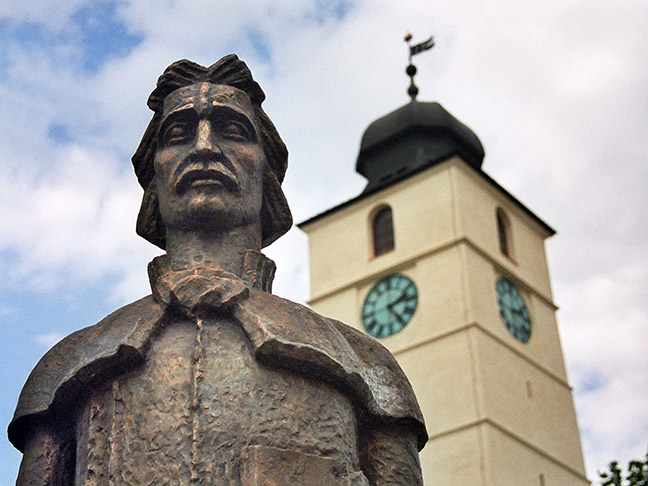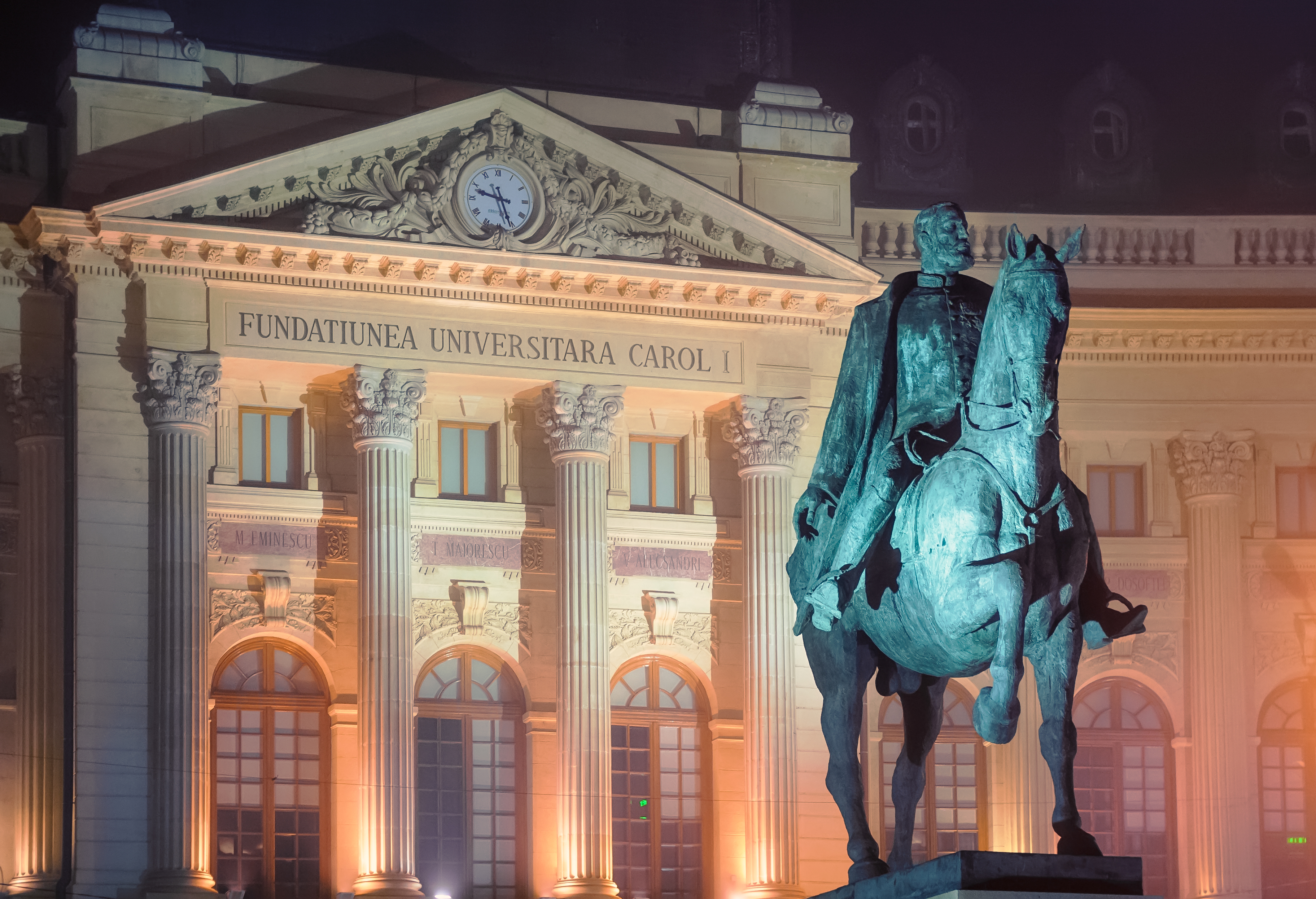|
Gheorghe Lazăr
Gheorghe Lazăr (5 June 1779 – 17 September 1823), was a Transylvanian Romanian scholar and the founder of the first Romanian language school in Bucharest, in 1817. Biography Lazăr was born to a peasant family in Felek, Szeben County, Habsburg Empire, today Avrig, Sibiu County, Romania. He studied in Nagyszeben (Sibiu), Kolozsvár (Cluj-Napoca), and Vienna, training in theology, but also interested in history and philosophy. The strong admiration he had for Napoleon I, as well as other radical opinions he expressed, prevented him from becoming a priest. He later had to flee for Wallachia, where he worked as a tutor and engineer, drawing admiration from boyar Constantin Bălăceanu, who was charged with the administration of schools throughout the Principality. His school signified the break with a tradition of schooling in Greek language, Greek (prevalent under Phanariote rule), and also marked a step towards secularism in education. Lazăr was one of the first wave of Roman ... [...More Info...] [...Related Items...] OR: [Wikipedia] [Google] [Baidu] |
Gheorghe Lazar
Gheorghe is a Romanian language, Romanian and Aromanian language, Aromanian given name and surname. It is a variant of George (name), George, also a name in Romanian but with soft Gs. It may refer to: Given name * Gheorghe Adamescu (1869–1942), Romanian literary historian and bibliographer * Gheorghe Albu (1909–1974), Romanian footballer * Gheorghe Alexandrescu * Gheorghe Andriev (born 1968), Romanian sprint canoeist * Gheorghe Apostol (1913–2010), Romanian politician, deputy Prime Minister of Romania and a former leader of the Communist Party * Gheorghe Apostoleanu (1832–1895), Romanian politician * Gheorghe Argeșanu (1883–1940), Romanian general * Gheorghe Arsenescu (1907–1962), Romanian Army officer * Gheorghe Asachi (1788–1869), Moldavian polymath * Gheorghe Băgulescu (1886–1963), Romanian general * Gheorghe Balș (1868–1934), Romanian engineer, architect and art historian * Gheorghe Bănciulescu (1898–1935), Romanian aviator * Gheorghe Banu (1889–1957), ... [...More Info...] [...Related Items...] OR: [Wikipedia] [Google] [Baidu] |
Constantin Bălăceanu
Constantin is an Aromanian, Megleno-Romanian and Romanian male given name. It can also be a surname. For a list of notable people called Constantin, see Constantine (name). See also * Constantine (name) * Konstantin The first name Konstantin () is a derivation from the Latin name '' Constantinus'' ( Constantine) in some European languages, such as Bulgarian, Russian, Estonian and German. As a Christian given name, it refers to the memory of the Roman empe ... References {{Reflist Aromanian masculine given names Megleno-Romanian masculine given names Romanian masculine given names Masculine given names Romanian-language surnames ... [...More Info...] [...Related Items...] OR: [Wikipedia] [Google] [Baidu] |
Communist Romania
The Socialist Republic of Romania (, RSR) was a Marxism–Leninism, Marxist–Leninist One-party state, one-party socialist state that existed officially in Romania from 1947 to 1989 (see Revolutions of 1989). From 1947 to 1965, the state was known as the Romanian People's Republic (, RPR). The country was an Eastern Bloc state and a member of the Warsaw Pact with a dominant role for the Romanian Communist Party enshrined in :Template:RomanianConstitutions, its constitutions. Geographically, RSR was bordered by the Black Sea to the east, the Soviet Union (via the Ukrainian Soviet Socialist Republic, Ukrainian and Moldavian Soviet Socialist Republic, Moldavian SSRs) to the north and east, Hungarian People's Republic, Hungary and Socialist Federal Republic of Yugoslavia, Yugoslavia (via Socialist Republic of Serbia, SR Serbia) to the west, and People's Republic of Bulgaria, Bulgaria to the south. As World War II ended, Kingdom of Romania, Romania, a former Axis powers, Axis membe ... [...More Info...] [...Related Items...] OR: [Wikipedia] [Google] [Baidu] |
University Of Bucharest
The University of Bucharest (UB) () is a public university, public research university in Bucharest, Romania. It was founded in its current form on by a decree of Prince Alexandru Ioan Cuza to convert the former Princely Academy of Bucharest, Princely Academy into the current University of Bucharest, making it one of the oldest Romanian universities. It is one of the five members of the ''Universitaria Consortium'' (a group of elite Romanian universities). The University of Bucharest offers study programmes in Romanian and English and is classified as an ''advanced research and education university'' by the Ministry of Education and Scientific Research (Romania), Ministry of Education. History The University of Bucharest was founded by the Decree no. 765 of 4 July 1864 by Alexandru Ioan Cuza and is a leading academic centre and a significant point of reference in society. The University of Bucharest is rich in history and has been actively contributing to the development a ... [...More Info...] [...Related Items...] OR: [Wikipedia] [Google] [Baidu] |
University Square, Bucharest
University Square () is located in Bucharest city centre, near the University of Bucharest. It is served by Universitate metro station. Four statues can be found in the University Square, in front of the university; they depict Ion Heliade Rădulescu (1879), Michael the Brave (1874), Gheorghe Lazăr (1889) and Spiru Haret (1932). The National Theatre Bucharest, Ion Luca Caragiale Bucharest National Theatre and the InterContinental Bucharest, Intercontinental Hotel (one of the tallest buildings in Bucharest) are also located near University Square. University Square marks the northeastern boundary of the Old Center of Bucharest. Since the end of 2014, after a project costing up to 65 million euros, the National Theatre has a new face, dominated by futuristic elements. History In the 15th century, here was the northern limit of the city. Around 1700, the limit was already around what is today Piața Romană (Roman Square). Thought to define the axes north–south and east–w ... [...More Info...] [...Related Items...] OR: [Wikipedia] [Google] [Baidu] |
Ialomița County
Ialomița County () is a county () of Romania, in Muntenia, with the capital city at Slobozia. Demographics In 2011, the county had a population of 258,669 and the population density was 58.08/km2. Romanians make up 95.6% of the population, the largest minority being the Romani people (4.1%). Geography Ialomița County has a total area of . The county is situated in the Bărăgan Plain. The area is flat crossed by small rivers with small but deep valleys. Its eastern border is on the Danube. The Ialomița (river), Ialomița River crosses the county from West to East about the middle. The Danube is split around the Ialomița Pond into the Old Danube branch and the Borcea branch. Until 1940 (in the western part) and 1967 (in the eastern part) the county/plain was home of the great bustard (''dropie'' in Romanian language, Romanian), with large populations of this bird. The birds disappeared because of the massive village buildout and hunting them for food. Neighbours *Co ... [...More Info...] [...Related Items...] OR: [Wikipedia] [Google] [Baidu] |
Gheorghe Lazăr, Ialomița
Gheorghe Lazăr is a Commune in Romania, commune in Ialomița County, Muntenia, Romania. It is composed of a single village, Gheorghe Lazăr. References Communes in Ialomița County Localities in Muntenia {{Ialomiţa-geo-stub ... [...More Info...] [...Related Items...] OR: [Wikipedia] [Google] [Baidu] |
Gheorghe Lazăr National College (Sibiu)
Gheorghe Lazăr National College () is a public day high school in Sibiu, in the Transylvania region of Romania, located at 1-3 Gheorghe Lazăr Street. History Latin and German periods The school was founded by the Jesuits in 1692 as a Catholic gymnasium, and Latin was the language of instruction. It was initially located in a small old building near a pharmacy on the Great Square, on the site of the present City Hall. In 1753, it moved to the upper story of a house located at the corner of what are now Mitropoliei and Samuel von Brukenthal streets. In 1773, when the Jesuits were suppressed, the school closed its doors. It reopened in 1780, when Emperor Joseph II approved its reorganization under the name ''Gymnasium regium Cibiniensis'' (Royal Sibiu Gymnasium). The administration was composed of local Roman Catholic chaplains; the teachers were Catholic priests, who continued to offer instruction in Latin. In 1789, the school moved into the former Jesuit residence in the Great ... [...More Info...] [...Related Items...] OR: [Wikipedia] [Google] [Baidu] |
Gheorghe Lazăr National College (Bucharest)
{{disambig ...
Gheorghe Lazăr National College () may refer to one of two educational institutions in Romania: * Gheorghe Lazăr National College (Bucharest) *Gheorghe Lazăr National College (Sibiu) Gheorghe Lazăr National College () is a public day high school in Sibiu, in the Transylvania region of Romania, located at 1-3 Gheorghe Lazăr Street. History Latin and German periods The school was founded by the Jesuits in 1692 as a Catholic ... [...More Info...] [...Related Items...] OR: [Wikipedia] [Google] [Baidu] |
Moldavia
Moldavia (, or ; in Romanian Cyrillic alphabet, Romanian Cyrillic: or ) is a historical region and former principality in Eastern Europe, corresponding to the territory between the Eastern Carpathians and the Dniester River. An initially independent and later autonomous state, it existed from the 14th century to 1859, when it united with Wallachia () as the basis of the modern Romanian state; at various times, Moldavia included the regions of Bessarabia (with the Budjak), all of Bukovina and Hertsa region , Hertsa. The region of Pokuttya was also part of it for a period of time. The Moldavia (region of Romania) , western half of Moldavia is now part of Romania, the eastern side belongs to the Moldova , Republic of Moldova, and the Chernivtsi Oblast , northern and Budjak , southeastern parts are territories of Ukraine. Name and etymology The original and short-lived reference to the region was ''Bogdania'', after Bogdan I, the founding figure of the principality. The name ... [...More Info...] [...Related Items...] OR: [Wikipedia] [Google] [Baidu] |



